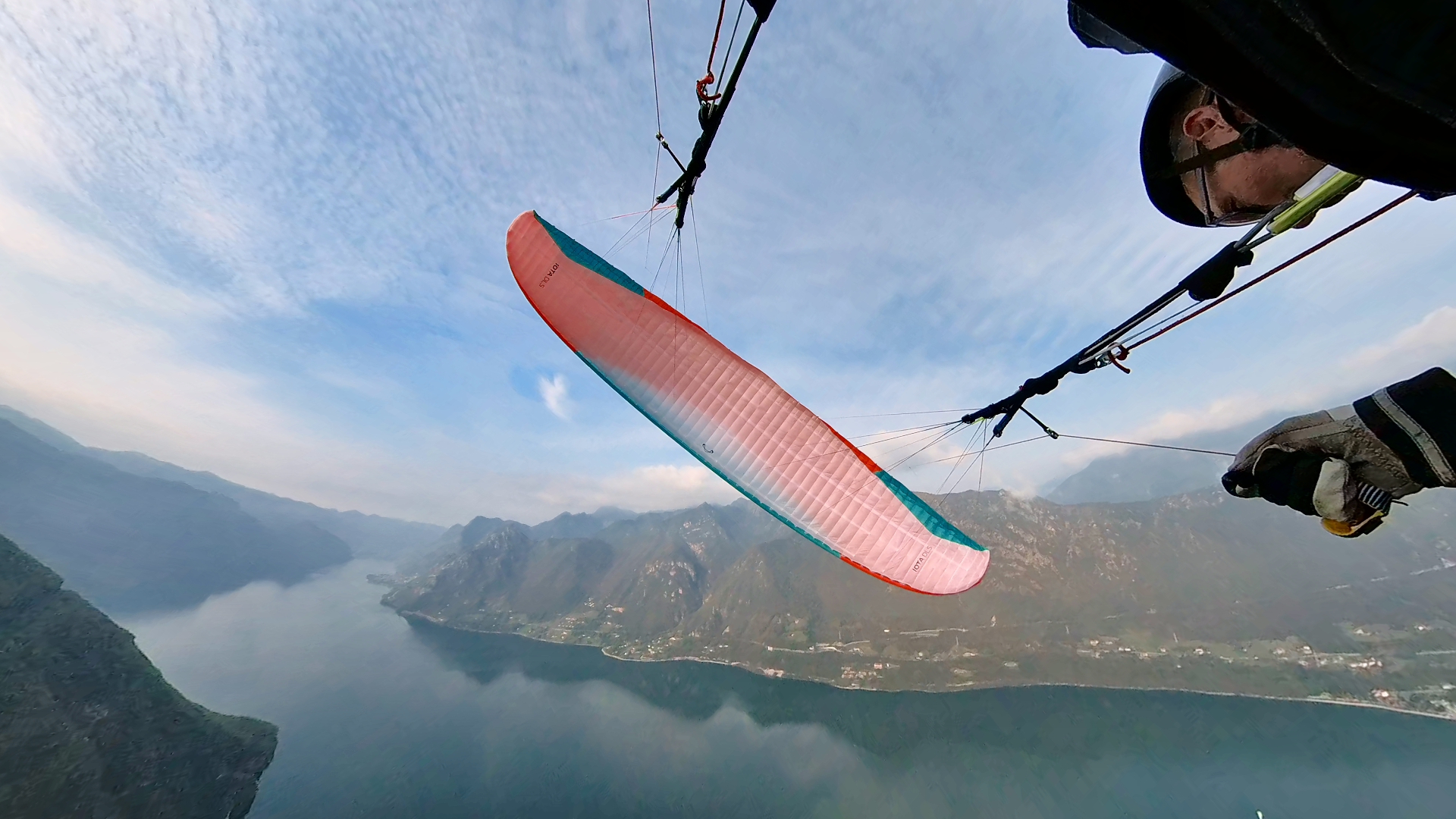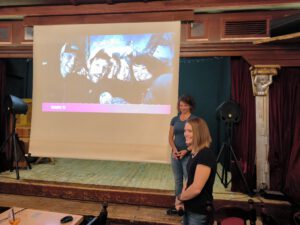I’m actually a real safety training grouch, but since my last safety training was over 5 years ago, I still had enough holiday left, got the OK from my wife and the Flugschule Achensee still had places available at the beginning of October, I signed up there.
Preparation
The Flugschule Achensee offers a free workbook to download from their website (only in german available). It is highly recommended that you read through the tips and advice very carefully, as well as the exercises that you want to carry out in the safety training. Be careful if you have chosen a different flight school for your safety training, as details in the exercises may vary.
I also had a training day in Kössen beforehand, during which I performed various simple exercises (rolls, pitches, fast figure eights, ears and moderate spiral dives), which I have mastered reasonably well, on my own. Kössen is ideal for a training day as the take-off area is close to the mountain station, the landing area is close to the valley station and you can buy a day ticket with as many ascents as you like.
Equipment
As I was probably planning to switch back to EN-B and I flew the first version of the Advance IOTA a few years ago, I picked up the current IOTA DLS as a tester. I wanted to test the wing extensively before finally deciding to buy it, and where better to do that than on a safety training course?
I have removed everything I don’t need for flying from the harness, e.g. my radio, power bank, windscreen, etc. The radio and life jacket are provided.

I installed my 360° action cam on my cockpit using a magnetic mount for later video analysis, as you can see in the photo.
I also had my smartphone in a waterproof case and the vario with me. The vario might not have been needed, but I wanted to record the flight track.
If you want to make as many flights as possible, it is helpful to use a quick pack. Then you can do 3 flights a day, but you have to be a pig and unpack at the front at the launch site and be one of the first to line up for take-off. As you put a plug from the radio in your ear, it is advisable to secure the plug with a tube scarf so that it does not fall out.
Location
The safety training took place at Lake Idro, which lies to the west of the famous Lake Garda. Although Lake Idro is developed for tourism with campsites and hotels, it is nowhere near as crowded as Lake Garda. Lake Idro is surrounded by karst mountains and, similar to Lake Garda, is often blown over by a southerly wind in the afternoon, as Lake Idro is also south-north orientated. This can sometimes be so strong that it is no longer flyable. There are various supermarkets in the village of Ponte Caffaro, so self-catering is also well catered for. It is a good idea to stay at Camping Miralago, as this is also the starting point for the trip to Monte Alpo Bondone in the morning. However, some participants were also accommodated in hotels in the surrounding area.
There is also the Miralago restaurant with a selection of pizzas that are highly recommended. The insider tip is the Pizza Stefano, named after our safety trainer Stefan.
The shuttle provided by the flight school takes about 30 minutes to drive up to Monte Alpe Bondone, and a further 5 minutes’ walk takes you to the launch site.
From the campsite, it’s a 15-minute walk in a westerly direction to Idroland. The video analysis took place there in the afternoon.
Get to know us
On the first day at 14:00, the participants met on the beach at the Miralago campsite to get to know each other. The participants were divided into 2 teams, each with around 20 participants. I had registered with Stefan.
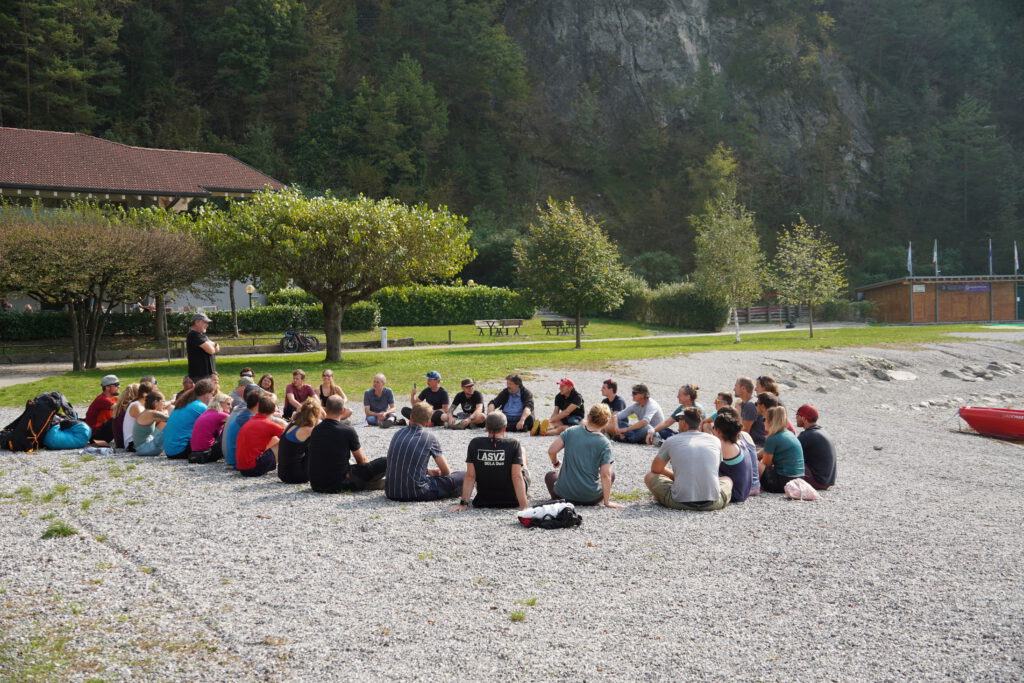
We were welcomed by Lucas, who explained a few basic things about the process, organisation and location. Each of us was then allowed to briefly introduce ourselves. Later, the teams split up and we walked with our coach Stefan to Idroland, where further details on the above points were explained.
Targets

At Idroland, we were asked about the goals we had set ourselves for the safety training. We were asked to rate ourselves on a scale of 1 to 10.
I myself had chosen the exercises steep spiral, accelerated held side collapses, accelerated front collapses, wingovers, stalls on one and both sides and spontaneously the Hermann.
The goals of the other participants were very different, ranging from simply gaining confidence to SAT. We were also asked about our medical knowledge. Fortunately for us, there was a doctor and a nurse among the participants.
Daily routine
The day often ran as follows. The times were adapted to the circumstances on a daily basis:
- Meeting at 7.00 am at Café Miralago with discussion of the previous day and dry runs
- Meeting at the shuttle at 7.30 a.m. followed by a drive to the launch site
- As soon as the wind is right, usually around 10.00 am, the first launches are made, the last launches at around 13.00
- Lunch break from 13:00 to 14:30
- Meeting at Idroland at around 14:30 to carry out a detailed video analysis
- If the weather allowed it, there was still the opportunity to enjoy a flight in the evening atmosphere or to use the southerly wind for groundhandling
- In the evening we met for a relaxed chat and a delicious pizza at the Miralago restaurant
Dry run
In the morning, dry runs took place at Café Miralago, as you can see in the photo. I assume that we practised the one-sided deflation in the photo.
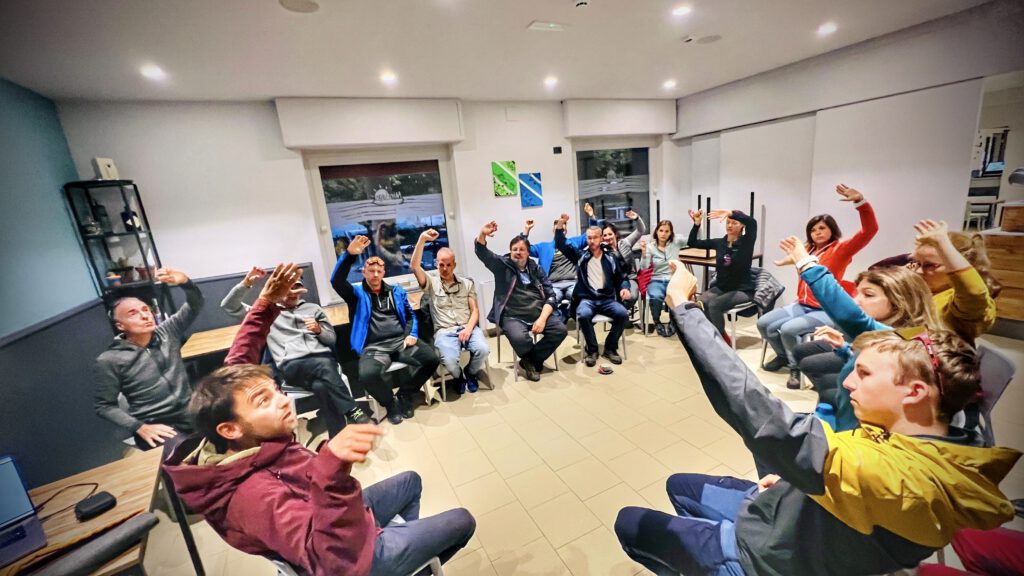
However, further questions about exercises and the daily schedule were clarified.
Take off
The launch site on Monte Alpe Bondone is south-facing and quite steep. At the same time as our training, there was another safety training session organised by the Flugschule Aufwind. As you can see in the photo, the launch site offers enough space to prepare and lay out the gliders. In the morning we often had to launch forwards due to the lack of wind, but later in the day we were often able to launch reverse due to the south wind.
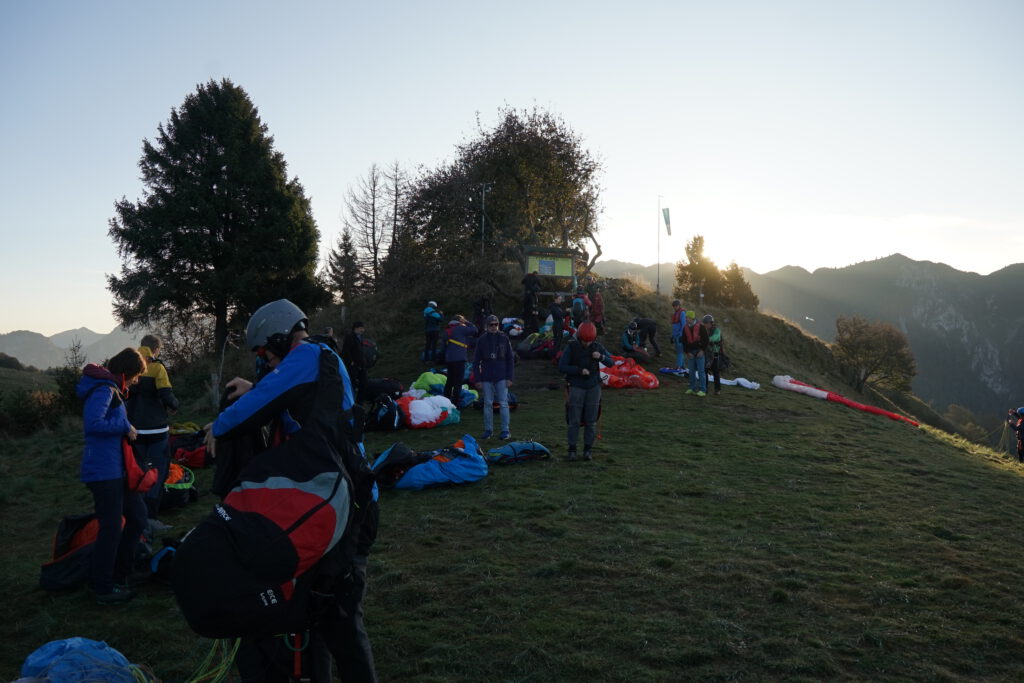
Fortunately, we had Eki Maute as launch leader, who carried out dry runs with us, answered final questions and also shared some of his wisdom, the keyword being “Hang Loose”. He brought calm to the launch site in his own way, I think almost every participant was already nervous enough.
Training
The launch site is at an altitude of 1540 metres. You have to fly a short distance to Lake Idro. The exercises took place from an altitude of approx. 1100 metres, the landing site at Idroland is at an altitude of 360 metres. Exercises were carried out up to an altitude of approx. 500 to 600 metres, so that a working height of approx. 500 to 600 metres was available for the exercises.
During the pre-flight from the launch site to the lake, we were asked to report to Stefan as soon as the pilot in front of us had finished his exercises, stating our first name, paraglider model, glider colour and desired exercises.
Below is a brief explanation of the exercises with manoeuvre critique that I carried out. The details of the individual exercises, such as aim and background, technique introduction, technique recovery and tips can be found in the Flugschule Achensee workbook (only in german available).
Steep spiral
The spiral dive, the classic part of most safety training courses. I had already practised it before in Kössen, but wanted to consolidate my skills under a trained eye. As I was flying with a tester, I didn’t want to push the spiral dive to the limit and risk a water landing, so my spiral dives were rather moderate. This also applies to all other exercises.

The halber Schlag (I don’t know the english translation), which is recommended by the Achensee flying school, actually gives me more control. Previously, I always flew my exercises with a French grasp.
According to Stefan’s taste, the spiral dives could have been done more sharply, but I didn’t want to do that for the reasons mentioned above. The gentle exit caused me difficulties, either the exit took too many turns or it ended in a “French exit”. During the second spiral dive, the earplug fell out of my ear so I couldn’t hear Stefan, who was getting more and more nervous and told me to finish the spiral dive ;-).
B-Stall
I practised the B-stall to have an alternative to the ear formation and steep spiral. The IOTA DLS does not tend to form a horseshoe.

For some reason I thought I had to stall the glider after releasing the B-stall, which is of course a mistake, but the glider must be able to restart.
Stall on both sides
The stall point is very clearly indicated by the IOTA DLS with a sudden drop in control pressure, which is reassuring to know. The recovery also went smoothly, I only had to catch the glider briefly.

Stall on one side
The stall on one side was also largely easy to initiate and worked well.

Deflation accelerated on one side, intercepted with brake
During the one-sided collapse I accelerated (approx. 50%) and held the open side too strongly, with the consequence that the glider turned in towards the open side.
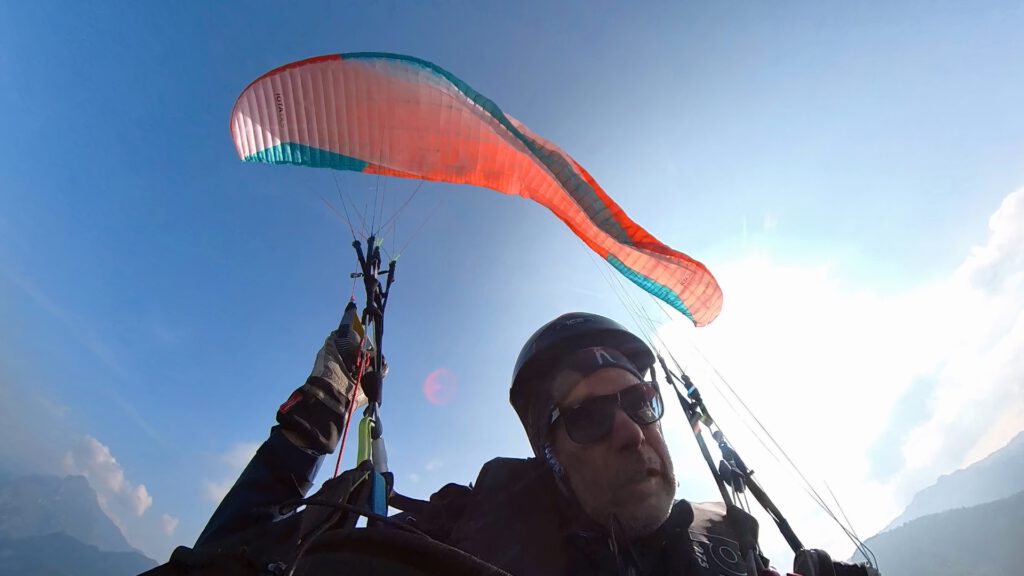
Deflation accelerated on one side, intercepted with C-row
That’s why Stefan suggested intercepting the collapse with the C-row, which worked much better. I was able to keep the glider in straight flight, as it should be. With the IOTA DLS, the collapses opened quickly and easily after release.
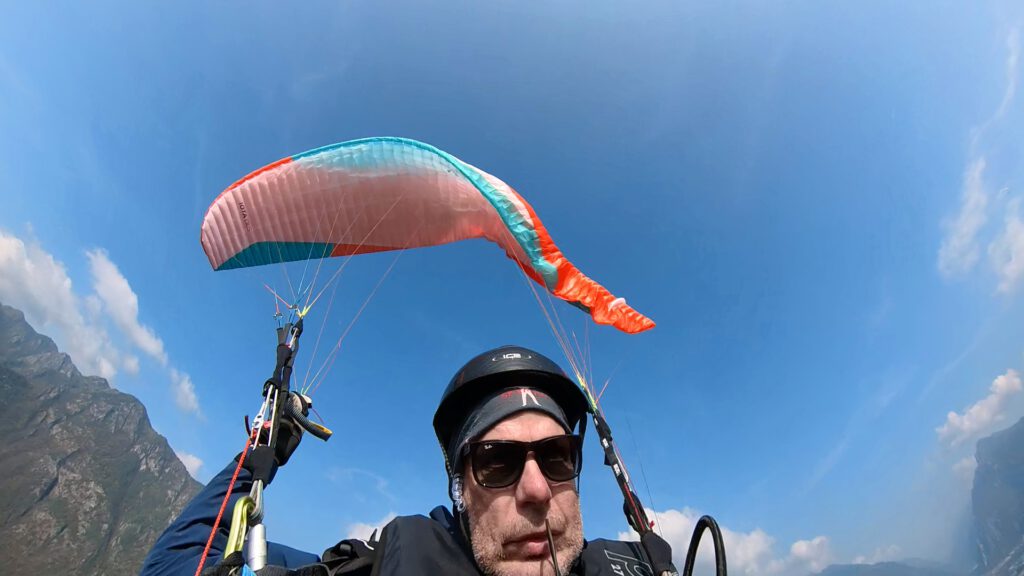
Front deflation unaccelerated
The IOTA DLS opened completely and symmetrically after a front deflation.

Wingover
The only exercise that hasn’t worked at all yet. But it is well known that the wingover requires a lot of practice and coordination, so I will certainly need many more flights before I get the wingover right. I like the video by Theo de Blic, who has produced a very good instructional video for a step-by-step introduction to learning the wingover.

Hermann
The toughest exercise for me, the Hermann. Named after Eki’s grandad. Right at the start of the exercise, my action cam was ripped off the magnetic mount.

Stefan was unavailable on the last day and so Eki was our new trainer. Eki let me do a few rotations, he probably sensed that I would have liked to finish the exercise straight away. But in the end, the exercise was fun.
Video analysis
In the afternoon, a detailed video analysis took place at Idroland. Videos were shown of various test candidates, and Stefan explained to us what didn’t go so well and what could have been done better. Our questions were also answered and the exercises we planned to do the next day were discussed. On the whole, the video analyses were very instructive, but there were also points of criticism, see the conclusion section.
Ground handling and evening flight
Right next to the Idroland, the evening southerly wind could be used for extensive groundhandling.
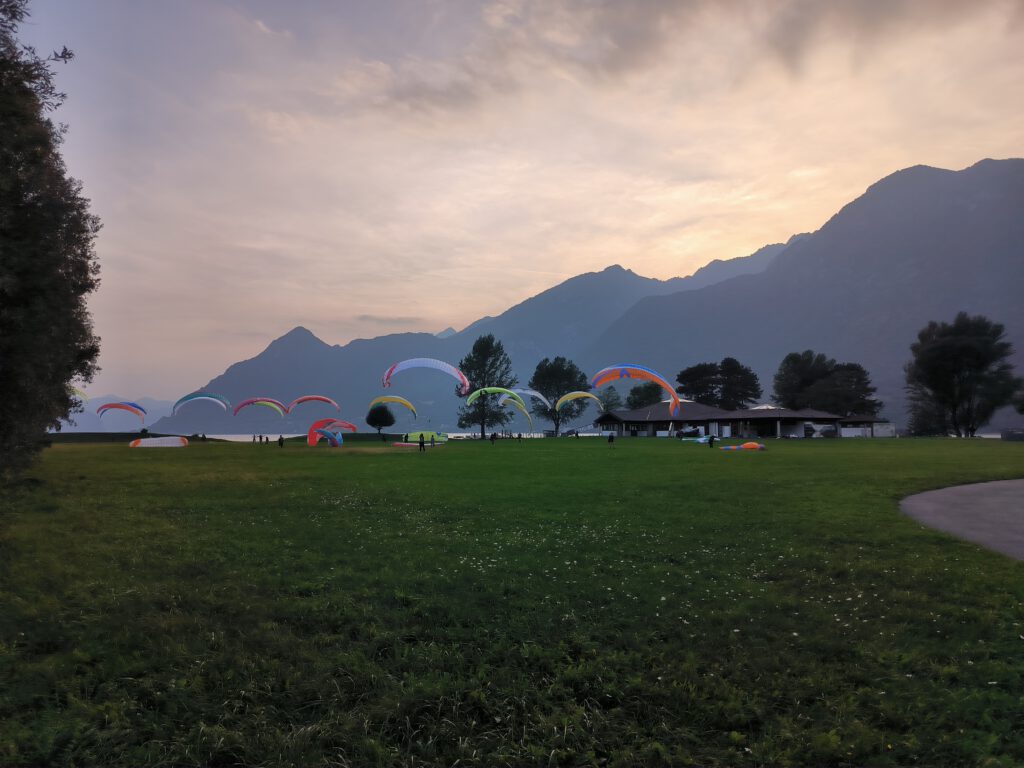
Others decided to enjoy a nice evening flight, a shuttle was provided by the flight school. The flight could have lasted longer due to the reversing thermals.
Conclusion
Most of the other participants were still relatively at the beginning of their careers but, much to my amazement, had few inhibitions about doing advanced exercises. This was probably because Stefan and Eki kept encouraging us to push ourselves to our limits. “When, if not in safety training, can you push yourself to your limits?” was one of the messages. We were also encouraged to stay on the ball and to continue the exercises, either on our own responsibility or in the next safety training course.
From my point of view, the video analysis was not quite as positive. I would have liked to have seen more of a culture of discussion, and the one or other question was not answered in as much depth as I would have liked. In addition, a water landing that happened on the very first day was dealt with in great detail. One or two interesting flights were lost.
All in all, however, the days were very instructive and motivating to stay on the ball, even for me as a safety training grouch.
